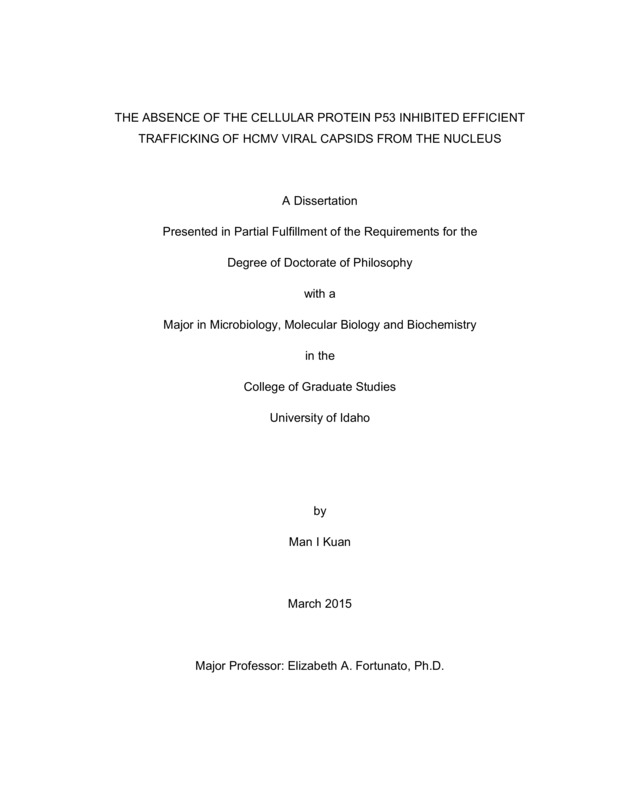THE ABSENCE OF THE CELLULAR PROTEIN P53 INHIBITED EFFICIENT TRAFFICKING OF HCMV VIRAL CAPSIDS FROM THE NUCLEUS
KUAN, MANI. (2015). THE ABSENCE OF THE CELLULAR PROTEIN P53 INHIBITED EFFICIENT TRAFFICKING OF HCMV VIRAL CAPSIDS FROM THE NUCLEUS. Theses and Dissertations Collection, University of Idaho Library Digital Collections. https://www.lib.uidaho.edu/digital/etd/items/kuan_idaho_0089e_10495.html
- Title:
- THE ABSENCE OF THE CELLULAR PROTEIN P53 INHIBITED EFFICIENT TRAFFICKING OF HCMV VIRAL CAPSIDS FROM THE NUCLEUS
- Author:
- KUAN, MANI
- Date:
- 2015
- Embargo Remove Date:
- 2016-05-12
- Keywords:
- Human cytomegalovirus Infoldings of the inner nuclear membrane Nuclear egress p53 Transmission electron microscopy (TEM) UL50 / UL53
- Program:
- Biology
- Subject Category:
- Virology; Cellular biology; Biology
- Abstract:
-
Human Cytomegalovirus (HCMV) infection is compromised by the absence of cellular p53. p53's activation leads to cell cycle arrest and/or apoptosis. HCMV-infection stabilizes p53 protein, however normal p53-mediated responses are inhibited. Fibroblasts lacking p53 (p53KOs) were used to study this protein's role during HCMV infection. Earlier studies found p53KOs produced 25-fold lower viral titers compared to parental wild type (wt) Lox cells. In this study we have investigated the source of the decreased functional virion production in p53KOs. Infectious center assays found most p53KOs released functional virions. Electron micrograph analysis revealed modestly decreased capsid production in p53KOs compared to wt. Significantly fewer p53KOs displayed HCMV-induced infoldings of the inner nuclear membrane (IINMs). The IINMs present in p53KOs were smaller and fewer. Reduced numbers of capsids were found in the cytoplasm and a disproportionately smaller number present were enveloped. Negatively stained infected p53KO cell supernatant found vastly fewer viral particles. Reintroduction of p53 into the KO cells substantially recovered these deficits. The absence of p53 inhibited the primary HCMV nuclear capsid egress portal and re-envelopment of the reduced number of particles able to reach the cytoplasm.
Having identified the structural deficit by electron microscopic analysis, we extended the study to the effect of p53's absence on HCMV's nuclear egress machinery. Normal egress requires nuclear lamina phosphorylation and remodeling. KOs expressed functional lamina phosphorylation-linked viral kinase UL97, however this did not lead to remodeling. A failure to remodel suggested malfunctioning of the nuclear egress complex (NEC). A key NEC protein, UL50, was expressed in nearly 100% of all cell types. It re-localized to the nucleus in ~90% of wt cells, but only ~40% of KOs nuclei. Re-introduction of p53 recovered UL50 nuclear re-localization to ~75%. All cells containing UL50 nuclear signal always displayed nuclear rim staining, co-localized with its binding partner, UL53. UL50/53 was seen as "threads" extending from the INM. These structures were smaller or absent in infected KOs. We believe these structures were tubular IINMs. The absence of p53 inhibited the wt behavior of UL50, preventing formation of IINMs, drastically reducing capsid nuclear egress.
- Description:
- doctoral, Ph.D., Biology -- University of Idaho - College of Graduate Studies, 2015
- Major Professor:
- Fortunato, Elizabeth
- Committee:
- Alderete, John; Miura, Tanya; Stenkamp, Deborah
- Defense Date:
- 2015
- Identifier:
- KUAN_idaho_0089E_10495
- Type:
- Text
- Format Original:
- Format:
- application/pdf
- Rights:
- In Copyright - Educational Use Permitted. For more information, please contact University of Idaho Library Special Collections and Archives Department at libspec@uidaho.edu.
- Standardized Rights:
- http://rightsstatements.org/vocab/InC-EDU/1.0/

